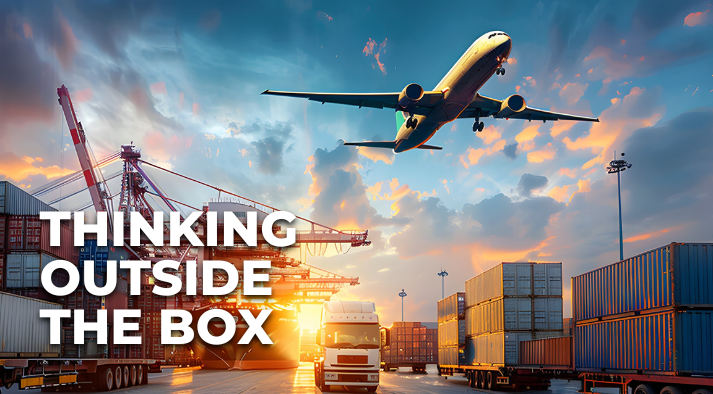 There’s no question that the impact of tariffs will ultimately hit those in last-mile logistics. But how? And what can carriers do while these and other issues are still in flux? Build the ability to flex and strengthen existing relationships with shippers. Those were the two pieces of advice for carriers coping with the dizzying changes involving tariffs and other fast-moving issues, from Guru Rao, CEO of nuVizz.
There’s no question that the impact of tariffs will ultimately hit those in last-mile logistics. But how? And what can carriers do while these and other issues are still in flux? Build the ability to flex and strengthen existing relationships with shippers. Those were the two pieces of advice for carriers coping with the dizzying changes involving tariffs and other fast-moving issues, from Guru Rao, CEO of nuVizz.
This Atlanta-based last-mile TMS platform has been arming carriers and shippers to ride the waves of change since 2013. “We help these companies optimize and better run their businesses so they can provide a better customer experience to all of their end customers. We help orchestrate the delivery process,” he says.
So, how does this “orchestrator” of the delivery process think about today’s dynamic situation involving tariffs? And how does he advise carriers to deal with this ever-changing environment? For Rao, it’s all about using technology to reinforce a company’s ability to adapt and using their people skills to stay close to the customers.
Get Ready for Disruptions

Rao made it clear that predicting the rise and fall of tariffs is a fool’s game. “I’m not even going to venture into predicting what might happen with tariffs tomorrow,” he said. “But I will predict we’ll always be dealing with disruption. And that’s nothing new for those in the last-mile. If you look at the logistics supply chain in general, in the last five to 10 years, there’s been a lot of volatility and unpredictability in the ecosystems thrown at us. The only constant is change. The environment we live in, and many of our customers live in, is unpredictable. We’ve always been used to this volatility, but now we live in a hyper-volatile, hyper-dynamic environment.”
He pointed out that many in the industry are experienced with disruptions. Those in the last-mile know how to react to issues caused by weather or the seasonality of the sales cycle. “We are all used to disruptions. We know things don’t go the way we plan. And that something will always go wrong. But that typically happens based on seasons. You do one thing in the summer. Something else in winter. You do things differently in one part of the country than in another. You can plan for these known unknowns to some extent because you have experience with them. But today, especially with the tariff situation, there is no way to plan for the variability in supply and demand that each change could bring. The variability in demand and supply can change every day. One day, the tariffs are high. So you will not get anything from certain countries. And another day it’s lifted. So you get a sudden rush to get everything into the country.
Rao talked about what he called the “bullwhip effect” for those at the tail end of the supply chain. “It’s a term we typically use in the context of inventory where the impact of supply and demand gets magnified by the time it reaches the last-mile. When it comes to the impact of tariffs, it’s all about the downstream impact of those policies,” he says. “That is where the last-mile players are challenged to respond to an ever-changing demand. If you are moving 100 orders today and suddenly have to move 500 orders tomorrow, it cannot happen without the right assets in place. Where are you going to get those resources? That takes time and relationships. The nature of the business has become so volatile. And it’s tough for anyone to really predict or plan for it. But you still have to run your business. We cannot say, ‘I’m going to shut down shop for six months, wait for everything to settle down,’ and then come back and pick it up.”
Using Technology To Facilitate Flexibility
While you can’t predict change, you can arm your company with the tools to be more nimble. “No human can manually manage the changes at the pace we’re seeing today,” said Rao. “That is where the technology plays a huge role. You cannot predict what happens, but at least you can reduce your risk using technologies that help you face those challenges. No one can scale based on the demands being put in front of us today without help. Technology allows both couriers and shippers to be nimble in the face of change.”
For shippers, those changes may involve how many products they bring in and need to get out. “If you look at it from a shipper’s perspective now, they may have to bring in two times what they used to generally buy in the face of an upcoming tariff. With their existing carrier base, they can only support what they had on hand in the past. However, with today’s inventory, they need to find new delivery partners to move it. If they do it the traditional way, they’d have to take time to negotiate contracts, bring a carrier on board, and get them into the network. They don’t have the time in today’s world. That’s where technology comes in. They can bring in a new carrier with minimal disruption, add more resources to their network, and make it work faster with today’s technology.”
That same process takes place at the carrier level. Technology helps them scale up or down. To bring in additional resources as quickly as possible when needed. “The right technology allows carriers to easily tap into the resources they need to respond to changing supply and demand levels. To be able to react to changing requirements,” Rao says. “That means the carrier doesn’t have to use their energy to follow every chain. They can use their mental energy to get the technology to the point where it can flex up or down, no matter what happens. And make sure customers know they have the technology to respond, no matter what disruptions hit. Today, that’s all about tariffs. Tomorrow I’m sure it’s going to be something else.”
Strengthen Relationships with Shippers
Rao’s second piece of advice is about the people side of the equation. “It’s all about strengthening your relationships with shippers,’ he points out. “Understand that everybody is going through the same pain. As a carrier, the best thing you can do is understand the shipper’s pain. And if you are a shipper, understand the carrier’s pain. We have to look at it on a humanistic level, which adds a little empathy to all of this. Technology can’t do that. AI can’t do that. People can do that. “At the end of the day, we all know this craziness will end. What won’t change is the need to nurture human relationships. As long as we maintain those, people will be more understanding. It’s important to keep those relationships as healthy as you can. We are all part of a network. Today, more than ever, we have to spend much time keeping and maintaining that network.”
Rao points out that technology can free up team members’ time to build and solidify human relationships. “Think about how you can use tech to automate some of the tasks that take up your time,” he says. “Think about how you can automate your operations. Ask yourself, ‘What technologies help me do that?’ This is not about today’s problem. This is going to be an ever-present situation. We live in this hyper-volatile and hyper-dynamic environment, and I don’t expect this to die down anytime soon. So we need to be thinking about it in those terms, with technology as an enabler to help us be ready for those changes as they come about. Use the technology to free up more time to be human. If you spend an extra two hours trying to manage, you take away those two hours from talking to your customers, vendors, and team members. Technology gives you back those two hours. Then, your people can talk to other people. We are all human. Humans are better at interactions than any technology. AI is not there yet. I don’t think it is ever going to be there. I don’t think it will ever read a face and say, ‘Hey, you’re in pain, right?’ We humans can easily do that. So, the best use of our time is to create that human touch. Technology is good at doing things, so use it that way, and then use your people to elevate their game and have a more humanistic approach to our interactions with your partners.”
In the end, it’s not about tariffs. It’s not about change. That will always be with us. It’s the nature of the last-mile. To sum up Rao’s advice, it’s this: Prepare yourself to ride with the tide. Solidify your relationships with your customers. Then, you’ll be ready for whatever disruptions hit next.

